Someday We'll Put Harness on the Jeep
Country Gentleman - June 1942
By
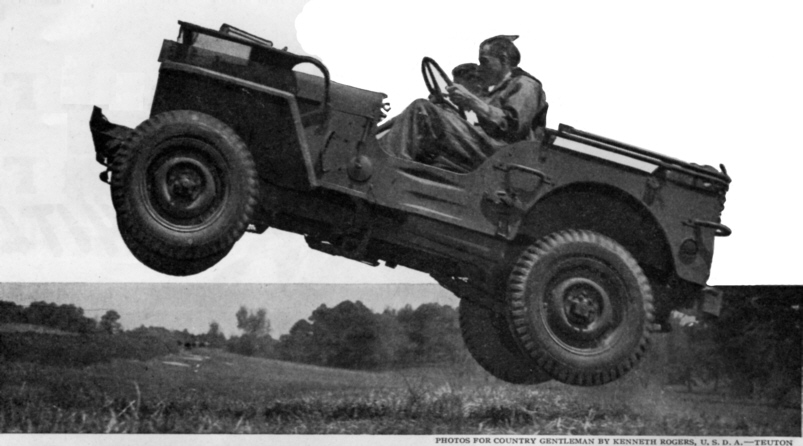 |
| Don Kenower, famous test drive, hurdles a terrace. His passenger is ag student Fred Curtis, who'll soon meet more jeeps in the field artillery. |
The first recorded plowing job by the jeep -
sometimes known as a peep and officially called a quarter-ton reconnaissance
Car - took place in
That unknown Yank was one of half a million lads in khaki who have been yearning to see the jeep perform all sorts of farm chores. When the shooting's over there probably will be tens of thousands of jeeps available for peacetime jobs. Already the War Department and the jeep manufacturers have been bombarded with letters asking how private citizens can obtain the little cars after the war.
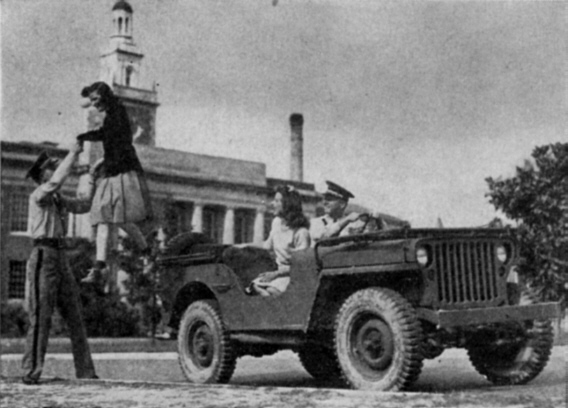 |
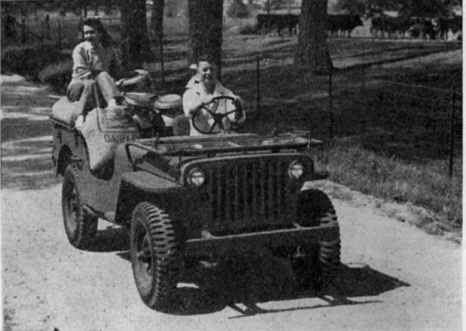 |
| "Just right for a campus date," Fred Curtis (driving) and Warren Patrick, Alabama Poly seniors, agree. They dressed in ROTC uniforms after helping test the jeep with coeds Ann Sherer (front) and Marjorie Gregory. | The versatile little cars hauls loads at a crawl through fields, or on this highway at 60. If farm boys now in uniform got their wish, Fred's and Ann's farm-to-market ride will be a familiar scene. |
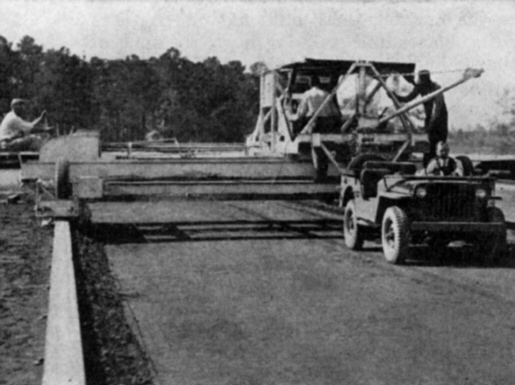 |
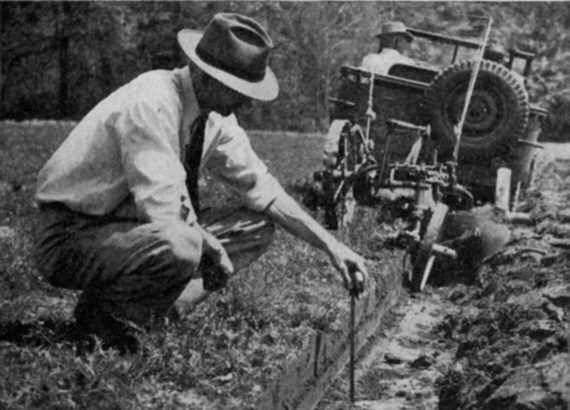 |
| First test for the jeep, by USDA ag engineers I.F. Reed and R.B. Gray, determines pull on the Auburn tillage lab's huge machine. Driver Kenower tugged 1300 pounds without a skid. | The Army's modern "mule" easily turned a 16-inch furrow in bottom land at four miles per hour. USDA engineer R.M. Merill checks the 7-inch cut. The driver wanted left-hand drive and a straight seat. |
There isn't an answer yet. We've got to win the war first. But in anticipation of that day, and to answer a lot of the questions in the minds of farmer boys in uniform who have cocked their eyes jeepward, at the suggestion of Country Gentleman editors the Army recently loaned a car to the Bureau of Agricultural Chemistry and Engineering of the Department of Agriculture for testing at Auburn, Alabama.
The
Bureau maintains a tillage laboratory at
In the opinion of ag engineer R. B. Gray, farm-machinery
chief for the Bureau who traveled from
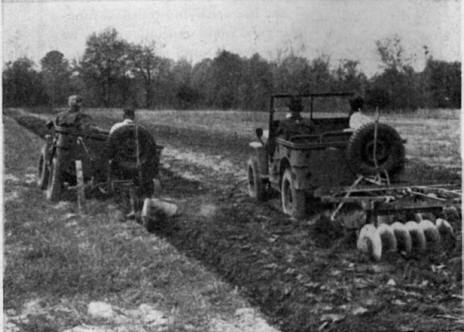 |
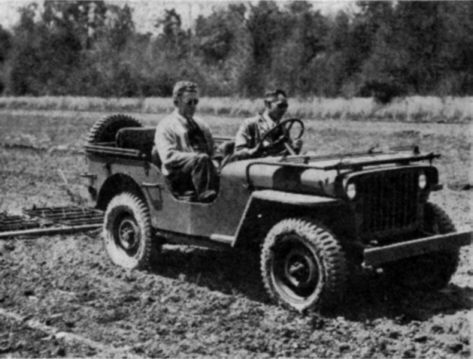 |
| Plowing and disking with a six-foot tandem harrow are simultaneous and swift as two jeeps pace across the field. Both machines got perfect traction under all conditions with four-wheel drive, in low-low gear. | Gray, Bureau of Agricultural Chemistry and Engineering's farm machinery chief, rides while a spike-toothed harrow finishes soil fitting. Corn planter and grain drill were later jeep hauled. |
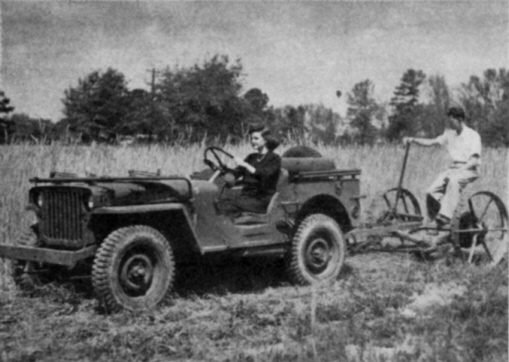 |
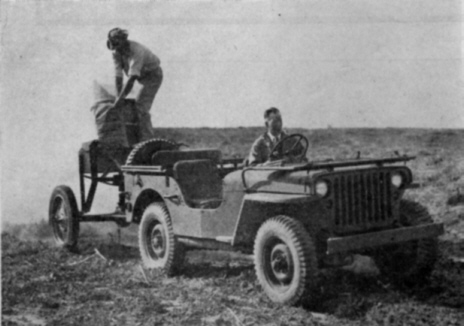 |
| Making a stand of rye with a jeep will be fun after the war, Warren Patrick and Marjorie Gregory decide. Warren is headed for the Air Corps. Marjorie and her friend Ann Both liked easy jeep steering. | Engineers Reed works hard to keep the rotary lime spreader filled as Kenower drives at ten miles per hour. All of the Department of Agriculture men took a turn behind the wheel, enjoyed jeep farming. |
Such a hitch, or drawbar was
quickly attached to the Army jeep at
The jeeps ran the needle up to 1300 pounds pull, with hardly a slip of the wheel as all four bit hard into the soil. Added weights cut down instead of increasing the pull, so perfectly are the little cars balanced, so evenly do the front wheels pull with the rear.
Although the jeep gear lever operates exactly like a passenger car, there are two additional small levers on the front floor. Pushing one forward changes the gear ratio and provides a low-low that functions only when all four wheels are driving. The other small lever shifts from four wheel to only rear-wheel drive, which is used when on the road and traveling in high. The effect of these multiple gears is to provide six speeds forward and two in reverse. The cars, incidentally, steer with a finger tip; and to the ordinary driver turn corners with surprisingly little urging.
During the plowing tots, and while pulling other heavy implements, the car stayed in low-low. Hauling a manure spreader and a rotary lime spreader, intermediate low was used.
Engineer R. M. Merrill, who has charge of the Auburn laboratory, and his associates E. D. Gordon and I. F. Reed, after computation with a field dynamometer and gasoline consumption apparatus, determined the following performance for the jeep, pulling a sixteen-inch plow: Drawbar horsepower, 8.51; drawbar pull, 862 pounds; speed, 3.7 miles per hour; fuel per hour, 1.35 gallons; draw. bar horsepower hours per gallon, 6.31; hours per acre, 1.72; and gallon. of fuel a gasoline) per acre. 2.32. In comparison with standard makes of one to two plow small tractors the drawbar horsepower is from one to three less; the pull about two thirds; the speed about half a mile an hour faster; and horsepower hours per gallon are about a third less.
"A lower gas, ratio would step up the drawbar pull." Mr. Gray believes, "and might result in less fuel consumption, since peak horsepower is obtained at about 3600 revolutions per minute. Few tractors peak over 1600 r.p.m."
There is a way to utilize the jeep, as delivered to the Army, for belt work, but this can be had at little extra cost. The Army requires all jeep transmission cars built with a removable plate and receptacle for a standard power take-off and there are can so equipped now used to drive generators and other apparatus in far corners of the globe.
"Versatile," is the Army's word for the jeep - so called originally because the official designation of the car began with the letters G. P. It was designed for scout and messenger service, but is now used for myriad tasks undreamed of for a vehicle costing $800. That same versatility will mark the jeep in agriculture when peaceful times come again, the Department of Agriculture experts agree.
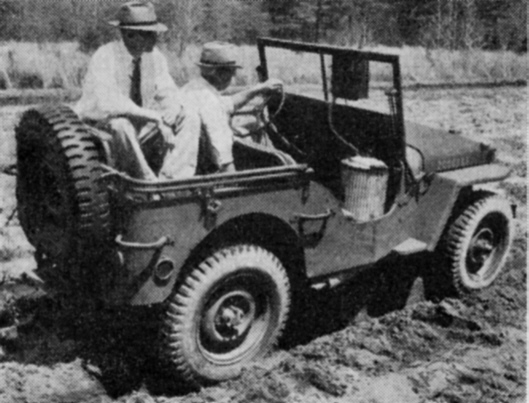 |
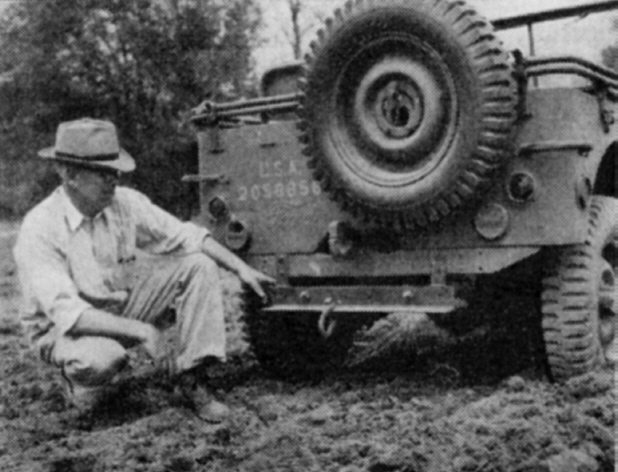 |
| Gas consumption test under load in field | Low hitch added for plowing. Pintle above. |
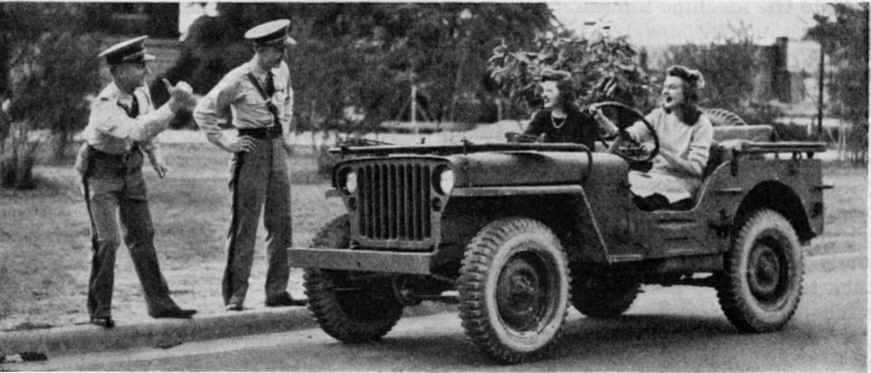 |
| "How's for a lift?" Ag students' fun is a symbol of farmer demands on the jeep after the war. |
